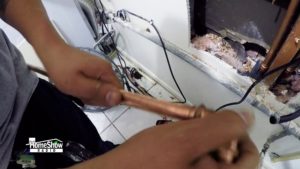Cured Place Pipe repair, or CIPP repair, is a sewer repair that requires minimal effort compared to other types. Crews don’t even need to dig into the sewer lines in many cases. It’s primarily used for minor issues that don’t require line replacement or upsizing. 
How Does Cured in Place Pipe Repair Work?
First, the crew will remove roots and debris from the affected pipe. Next, they will set up a sewer bypass that can send wastewater to other lines in the network. This, however, isn’t always necessary. The crew will set up a sewer vacuum to keep debris out, and a flexible liner will be inserted into the pipe via a manhole. Once inside, the crew will heat the liner or expose it to UV light. This cures the liner inside the pipe in a short period. The sewer line is reopened, the bypass is removed, and the crew performs a quality control inspection to ensure everything’s working correctly.
How Long Does Cured in Place Pipe Repair Take?
The entire process mentioned above can be completed in as little as an hour for smaller sections. It can take up to six hours for more significant sections or those more heavily used. If a home or neighborhood has to limit its water usage for a cured-in-place pipe repair, the authority in charge will notify them 24-48 hours in advance.
What Should We Do for a Cured in Place Pipe Repair?
Private property connections to the sewer line will be shut off during the repair. You’ll be asked to limit your water usage for the duration. This ensures that you don’t back up your private pipes and flood your home with wastewater. You’ll need to avoid using anything that requires a lot of water, such as:
- Dishwashers
- Washing machines
- Showers
- Bathtubs
Next, you should turn off any sump pumps that connect to the sewer. Try to limit flushing your toilets as much as possible. Don’t run water or pour any liquids down the drain if you can avoid it.
Does Cured in Place Pipe Repair Cause Other Inconveniences?
You’d notice the only other thing is an odor that smells like glue or plastic. This odor comes from the chemicals that make up the liner’s resin, and they’re detected in amounts well below any levels that could harm people or animals. An excellent way to get rid of the odor is to fill your floor drains and sinks with water before the repair starts. It’ll trap the odor molecules in the bends of your drain. If the odor’s in your house, open your windows and close your basement drains to allow proper ventilation.
